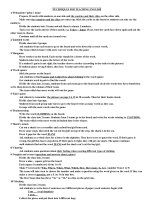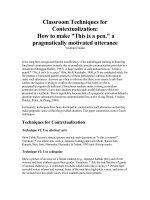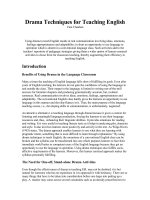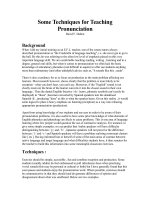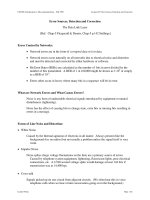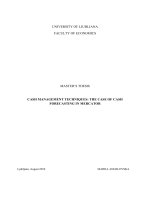Anomaly detection techniques
Bạn đang xem bản rút gọn của tài liệu. Xem và tải ngay bản đầy đủ của tài liệu tại đây (36.98 KB, 3 trang )
Anomaly Detection Techniques
What Are Anomalies?
Anomalies can be broadly categorized as:
Point anomalies: A single instance of data is anomalous if it's too far off from the rest. Business
use case: Detecting credit card fraud based on "amount spent."
Contextual anomalies: The abnormality is context specific. This type of anomaly is common in
time-series data. Business use case: Spending $100 on food every day during the holiday season is
normal, but may be odd otherwise.
Collective anomalies: A set of data instances collectively helps in detecting anomalies. Business
use case: Someone is trying to copy data form a remote machine to a local host unexpectedly, an
anomaly that would be flagged as a potential cyber attack.
Anomaly detection is similar to — but not entirely the same as — noise removal and novelty
detection.
Novelty detection is concerned with identifying an unobserved pattern in new observations not
included in training data like a sudden interest in a new channel on YouTube during Christmas, for
instance.
Noise removal (NR) is the process of removing noise from an otherwise meaningful signal.
1. Anomaly Detection Techniques
Simple Statistical Methods
The simplest approach to identifying irregularities in data is to flag the data points that deviate from
common statistical properties of a distribution, including mean, median, mode, and quantiles. Let's
say the definition of an anomalous data point is one that deviates by a certain standard deviation
from the mean. Traversing mean over time-series data isn't exactly trivial, as it's not static. You
would need a rolling window to compute the average across the data points. Technically, this is
called a rolling average or a moving average, and it's intended to smooth short-term fluctuations and
highlight long-term ones. Mathematically, an n-period simple moving average can also be defined as
a "low pass filter."
Challenges with Simple Statistical Methods
The low pass filter allows you to identify anomalies in simple use cases, but there are certain
situations where this technique won't work. Here are a few:
The data contains noise which might be similar to abnormal behavior, because the boundary
between normal and abnormal behavior is often not precise.
The definition of abnormal or normal may frequently change, as malicious adversaries constantly
adapt themselves. Therefore, the threshold based on moving average may not always apply.
The pattern is based on seasonality. This involves more sophisticated methods, such as
decomposing the data into multiple trends in order to identify the change in seasonality.
2. Machine Learning-Based Approaches
Below is a brief overview of popular machine learning-based techniques for anomaly detection.
a.Density-Based Anomaly Detection
Density-based anomaly detection is based on the k-nearest neighbors algorithm.
Assumption: Normal data points occur around a dense neighborhood and abnormalities are far
away.
The nearest set of data points are evaluated using a score, which could be Eucledian distance or a
similar measure dependent on the type of the data (categorical or numerical). They could be broadly
classified into two algorithms:
K-nearest neighbor: k-NN is a simple, non-parametric lazy learning technique used to classify data
based on similarities in distance metrics such as Eucledian, Manhattan, Minkowski, or Hamming
distance.
Relative density of data: This is better known as local outlier factor (LOF). This concept is based on
a distance metric called reachability distance.
b.Clustering-Based Anomaly Detection
Clustering is one of the most popular concepts in the domain of unsupervised learning.
Assumption: Data points that are similar tend to belong to similar groups or clusters, as determined
by their distance from local centroids.
K-means is a widely used clustering algorithm. It creates 'k' similar clusters of data points. Data
instances that fall outside of these groups could potentially be marked as anomalies.
c.Support Vector Machine-Based Anomaly Detection
A support vector machine is another effective technique for detecting anomalies.
A SVM is typically associated with supervised learning, but there are extensions (OneClassCVM, for
instance) that can be used to identify anomalies as an unsupervised problems (in which training data
are not labeled).
The algorithm learns a soft boundary in order to cluster the normal data instances using the training
set, and then, using the testing instance, it tunes itself to identify the abnormalities that fall outside
the learned region.
Depending on the use case, the output of an anomaly detector could be numeric scalar values for
filtering on domain-specific thresholds or textual labels (such as binary/multi labels).
In this jupyter notebook we are going to take the credit card fraud detection as the case study for
understanding this concept in detail using the following Anomaly Detection Techniques namely

